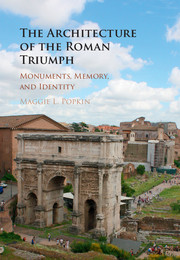Book contents
- Frontmatter
- Dedication
- Contents
- List of Figures
- List of Tables and Color Plates
- Acknowledgments
- INTRODUCTION: THE TRIUMPH, MEMORY, AND “BEING ROMAN” IN THE CITY OF ROME
- 1 THE TRIUMPHAL ROUTE
- 2 BUILDING MEMORIES: THE ERA OF THE PUNIC WARS (264–146 B.C.)
- 3 SPECTACLE AND MEMORY: THE REIGN OF TRAJAN, OPTIMUS PRINCEPS (A.D. 98–117)
- 4 MONUMENTS AND MEMORY DISTORTION: THE REIGN OF SEPTIMIUS SEVERUS (A.D. 193–211)
- CONCLUSION
- Appendix Victory Monuments Built along the Triumphal Route during the Punic Wars: Topography, Dating, and History
- Notes
- References
- Index
- COLOR PLATES
2 - BUILDING MEMORIES: THE ERA OF THE PUNIC WARS (264–146 B.C.)
Published online by Cambridge University Press: 05 July 2016
- Frontmatter
- Dedication
- Contents
- List of Figures
- List of Tables and Color Plates
- Acknowledgments
- INTRODUCTION: THE TRIUMPH, MEMORY, AND “BEING ROMAN” IN THE CITY OF ROME
- 1 THE TRIUMPHAL ROUTE
- 2 BUILDING MEMORIES: THE ERA OF THE PUNIC WARS (264–146 B.C.)
- 3 SPECTACLE AND MEMORY: THE REIGN OF TRAJAN, OPTIMUS PRINCEPS (A.D. 98–117)
- 4 MONUMENTS AND MEMORY DISTORTION: THE REIGN OF SEPTIMIUS SEVERUS (A.D. 193–211)
- CONCLUSION
- Appendix Victory Monuments Built along the Triumphal Route during the Punic Wars: Topography, Dating, and History
- Notes
- References
- Index
- COLOR PLATES
Summary
INTRODUCTION
The era of the Punic Wars marked Rome's emergence as a truly Mediterranean-wide empire. For the first time, Rome had to define itself in relation to cultures beyond the shores of Italy. This explosive geographic expansion led to a boom in triumphal processions and, concomitantly, construction of triumphal monuments in Rome. Many of these monuments were temples vowed during battle and paid for from manubiae – the proceeds of the spoils of war – by victorious generals. This chapter examines these manubial temples and other victory monuments built during this period, including porticoes, arches, and columns, which architecturally defined the length of the route for the first time in the triumph's history. This period was, at a fundamental level, when the triumphal route was built into existence as a codified and long-lasting processional urban space.
I argue here that Rome's Mediterranean conquests and the resulting triumphs spurred extraordinary innovation in metropolitan Roman architecture. The resulting visual characteristics of monuments along the triumphal route made them potent reminders of triumphal processions, shaping how Romans conceived of the triumph and, consequently, of themselves as Romans. The monuments of the triumphal route commemorated past triumphs. They nurtured historical memory of the Roman triumph, providing concrete reminders not only of the ritual institution of the triumph but of historical triumphal processions and the illustrious men who had celebrated them. Beyond encouraging people to remember past triumphs, however, they shaped how people remembered those triumphs and the institution more generally. By foregrounding aspects of foreign conquest and incorporating foreign architectural vocabularies, the monuments linked remembering the triumph with grappling with questions of self-definition as Romans in a rapidly widening Mediterranean context. Thus, the monuments of the triumphal route also, and just as importantly, generated conceptions of urban identity in the city of Rome. They did not merely reflect Rome's conquest of foreign cultures but actively participated in incorporating those cultures into changing conceptions of what it meant to “be Roman.” Finally, a major but unappreciated role of these monuments was to help Romans remember what future triumphs should be like – in essence, to create a template for how to perform triumphal processions. The permanent architecture of the route provided a backdrop against which the triumph could appear traditional even as it underwent often radical transformations.
- Type
- Chapter
- Information
- The Architecture of the Roman TriumphMonuments, Memory, and Identity, pp. 46 - 91Publisher: Cambridge University PressPrint publication year: 2016



